The confrontation between Joseph and his brothers is one of the most troubling stories of the Bible. Joseph and his brother—twelve sons of Jacob—were the progenitors of the twelve tribes of Israel. They are described as tzadikim (the righteous and pious men) and prophets. However, as we read in the Torah portion Vayeshev, we are told that brothers hated Joseph:
And when his brethren saw that their father loved him more than all his brethren, they hated him, and could not speak peaceably unto him. (Genesis 37:3)
And Joseph dreamed a dream, and he told it to his brethren; and they hated him yet the more. (Genesis 37:5)
And his brethren envied him… (Genesis 37:11)
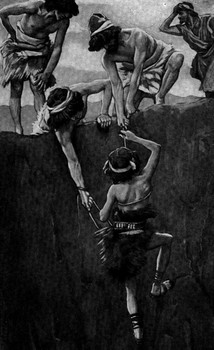 The brothers intended to kill Joseph:
The brothers intended to kill Joseph:
And they said one to another: ‘Behold, this dreamer cometh. Come now therefore, and let us slay him, and cast him into one of the pits… (Genesis 37:19-20)
Although the brothers did not actually kill Joseph, they threw him into a pit:
…and they took him, and cast him into the pit. (Genesis 37:24)
Ultimately, the brothers sold Joseph to the passing caravan of Ishmaelites:
…and they drew and lifted up Joseph out of the pit, and sold Joseph to the Ishmaelites for twenty shekels of silver. And they brought Joseph into Egypt. (Genesis 37:28)
On the surface, it appears as a story of sibling rivalry on steroids. A very disturbing story, if you take it at its face value. Indeed, the sages of the Talmud rebuke the behavior of the brothers. This criticism seems to clash with the characterization of the brothers as prophets and tzadikim. However, it seems that a great mystery is hidden beneath the surface.
To understand it, let us recall the mystical journey of Joseph’s grandfather, Isaac, that we discussed in the earlier post “Akeida in Parallel Universes.” According to Kabbalists, when Isaac was born, he received the female half of his soul. Having a female soul in the male body is why he could not get married. According to Kabbalists, G‑d had to orchestrate the Akeida—the Binding of Isaac—to swap Isaac’s soul. Is it possible that a similar dynamic underlies the intended killing of Joseph by his brothers and ditching him into a pit?
Rashi cites a midrash that describes Joseph’s behavior in his childhood:
He behaved childishly, fixing his hair and touching up his eyes so that he would appear handsome. (Genesis Rabbah 84:7)
The above seems more than a childish behavior—this seems more like a feminine behavior. It is more characteristic of girls to fix their hair often and touch up their eyes to look pretty.
Torah itself gives a hint at the feminine tendency of Joseph. This hint is in the story of his coat:
Now Israel loved Joseph more than all his children, because he was the son of his old age; and he made him a coat of many colours. (Genesis 37:3)
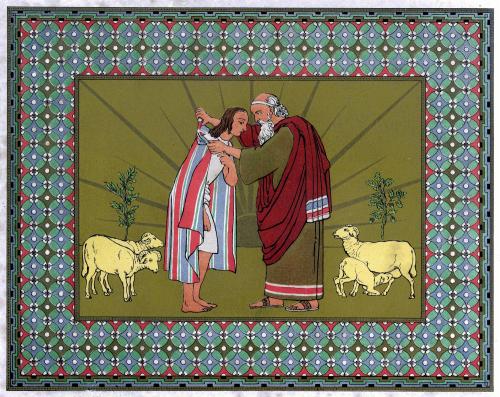
Israel loved Joseph more than all his children. (illustration by Owen Jones from the 1869 “The History of Joseph and His Brethren”)
The coat of many colors in the original Hebrew is ketonet passim. This expression is translated in many different ways besides the “coat of many colors”—as a “striped tunic,” as a tunic of fine wool, or a long coat. The reason for this ambiguity is the rarity of the expression “ketonet passim.” Besides the Torah portion, it appears in the whole of Scriptures only once more, in prophet Samuel:
Now she had a garment of many colours upon her; for with such robes were the king’s daughters that were virgins apparelled. (II Samuel 13:18)
The above verse relates to King David’s daughter, Tamar, who wore ketonet passim. This garment is identified explicitly as a dress worn by the virgin daughters of the king.
Why then did Joseph were this female garment? It seems that the Torah hints to us that this coat represented the feminine aspect of Joseph’s personality, which was rather prominent in his youth.
Maybe Jacob, blinded by his love for Joseph, did not pay any attention to Joseph’s femininity. But it surely did not escape his brothers, who found it very troubling. As prophets, they knew that Joseph was supposed to personify the Yesod (“Foundation”) of Zeer Anpin (“Small Face” or “Microprosopus”). As we discussed before, Zeer Anpin is a partzuf[1] representing the masculine principle in godliness as it is expressed in the universe of Tikkun. Yesod is a sefirah that anthropomorphically corresponds to the male organ. Thus, the Yesod of Zeer Anpin is the male aspect of the male principle—the pure and undiluted essence of masculinity. Joseph, as a youth, fell far short of his spiritual archetype he was destined to personify. Perhaps, his brothers did not hate Joseph, but they hated Joseph’s femininity that held him back from achieving his destiny.
It could be that the brothers knew that a similar situation once already took place in their family, when their grandfather, Isaac, received the female aspect of his soul at birth and required the Akeida to restore his masculinity. Conceivably, they decided that a similar procedure was needed to restore the masculinity of Joseph. Maybe this is why they decided to throw Joseph into the empty pit. The connection between Isaac’s Akeida and the pit becomes apparent in their numerical values. The gematria (numerical value) of Isaac is 208.[2] The gematria of the word “pit” (bor) is also 208.[3] Moreover, the connection between pit and Isaac is explicitly made by the Ari, who writes:
“They cast him into the pit”—this is the foundation of the attribute of judgment of Isaac, whose numerical value is the same as that of the word for “pit.”[4]
There is even more direct hint at the feminine nature of Joseph as a youth. The gematria of Joseph is 156.[5] This number is one less than the gematria of nukvah[6]—157—the female principle in godliness. If we were to assign to the coat that Jacob made for Joseph the value of 1, while wearing the coat, Joseph’s gematria 156+1 was equal precisely to the gematria of nukvah, 157. Maybe this is why the first thing the brothers did when they saw Joseph was to strip off his feminine coat before casting him into the pit:
And it came to pass, when Joseph was come unto his brethren, that they stripped Joseph of his coat, the coat of many colours that was on him (Genesis 37:23)
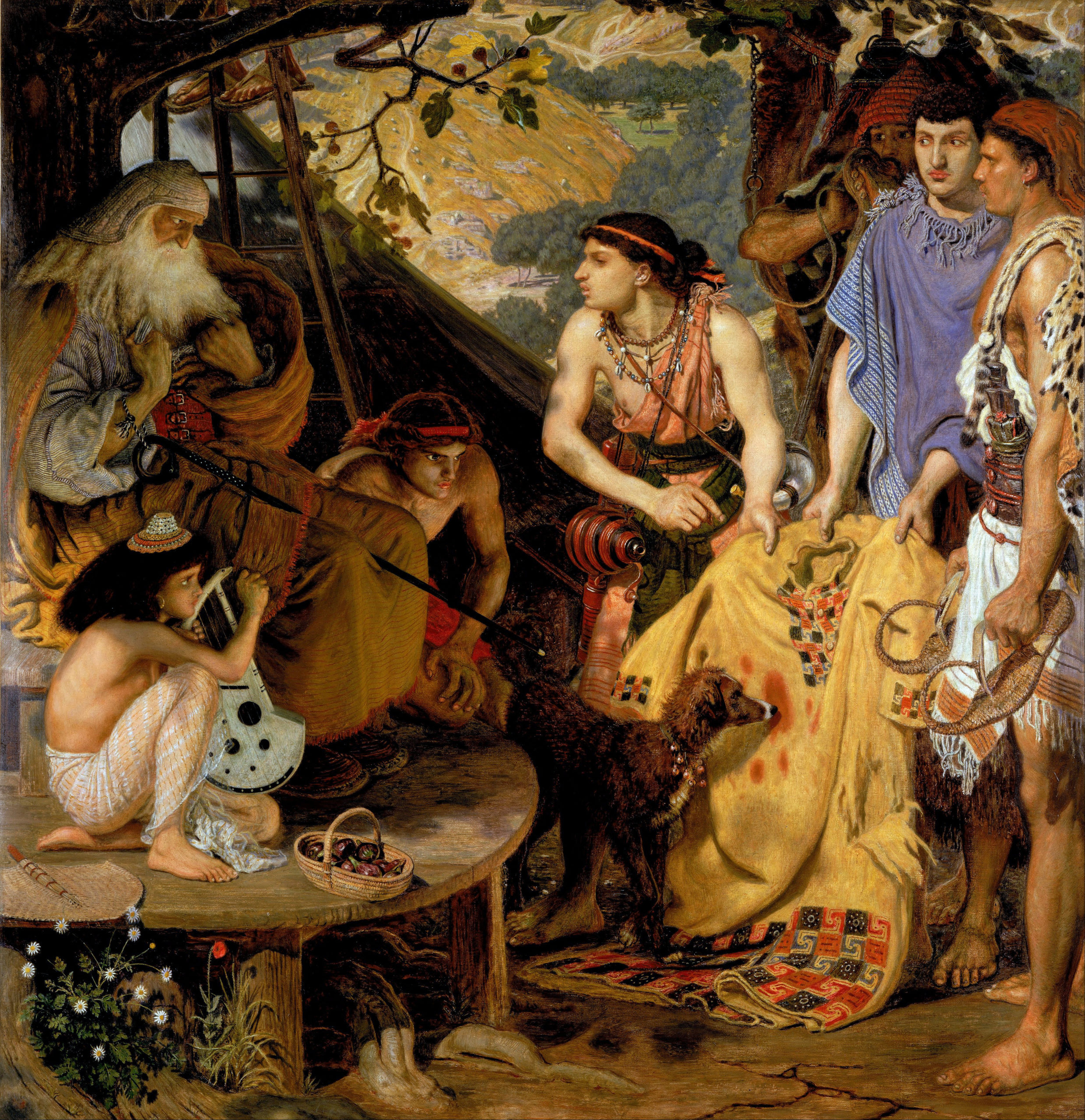
The Coat of Many Colours by Ford Madox Brown, c. 1864-1866
Now all pieces of the puzzle fit together. The brothers’ intention appears to be to strip Joseph from his feminine personality, thereby enabling him to achieve his destiny of personifying the Yesod of Zeer Anpin.
After I wrote this explanation last week, I decided not to publish it despite how compelling it appeared to be. After all, I have not heard it from my teachers, nor did I see it in the books of Kabbalah. We cannot make up such explanations on our own. This week, however, I found proof in the writings of the holy Ari. Commenting on this week’s Torah portion, Miketz, Arizal says:
[Joseph] derived his sustenance from the name Kel Kanah Havayah. This name signifies the supernal Yesod of the first heh of Havayah.[7]
To explain, the divine name, Kel Kanah Havayah,[8] is associated with Joseph because the word kana is grammatically related to (and has the same meaning as) the word kinah (“jealousy”), which has the same gematria 156 as Joseph.[9] The first letter heh in the name Havayah (Tetragrammaton) represents partzuf of Ima (the Supernal Mother). Thus, Arizal says that Joseph derived his sustenance from the Yesod of Ima.
Notably, the Arizal also views the conflict between Joseph and his brothers in terms of a gender identity conflict—ten brothers knew that each of them personified one sefirah of the feminine partzuf of Nukvah. In contrast, Joseph personified Yesod of the masculine partzuf of Zeer Anpin, and they were jealous (kinah) of him. The nuance that I would like to add to this picture is that the brothers were most angry that Joseph, having this great potential, was not living up to this potential as a youth.
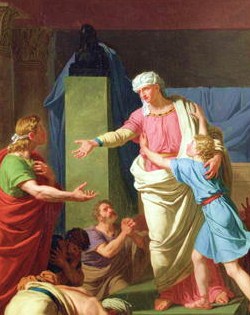
Benjamin (right) embracing his brother Joseph, by Charles Thevenin
Interestingly, according to the Arizal, Joseph was concerned about the masculinity of Benjamin (as much as, according to our interpretation, the brothers were concerned about the masculinity of Joseph).[10] When the brothers brought Benjamin to Egypt and Joseph saw him for the first time after twenty-two years, Joseph interrogated Benjamin to ascertain whether Benjamin derived his spiritual sustenance from the masculine axis or the feminine axis.[11] Although Benjamin was a younger brother, he and Joseph were spiritual twins, as it were. Benjamin, who emulated his older brother in everything, achieved the same spiritual levels as Joseph. It is possible that having experienced this gender ambiguity in his youth, Joseph was concerned about his younger brother experiencing similar issues and was relieved to find out that Benjamin was deriving his sustenance from the same (masculine) place as he was, and that Benjamin was married and had ten sons of his own.[12]
Having confirmed my hypothesis in the writings of the Arizal that the conflict between Joseph and his brothers was a gender conflict, I can now share it publicly. This new take on the Biblical conflict between Joseph and his brothers rooted in gender identity illuminates the contemporary discussions related to gender theory and gender identity.
—————————-
Endnotes:
[1] Zeer Anpin (Z”A) is a partzuf (divine configuration) comprising six lower sefirot called midot (“measures”): Chesed, Gevurah, Tiferet, Netzach, Hod, and Yesod.
[2] Yitzchak: yud (10) + tzadik (90) + chet (8) + quf (100) = 208.
[3] Bor: bet (2) + waw (6) + resh (200) = 208.
[4] Sefer HaLikutim, Parshat Miketz. See in English Rabbi Moshe Wisnefsky, “Apples From the Orchard: Gleanings From the Mystical Teachings of Rabbi Yitzchak Luria (the Arizal) on the Weekly Torah Portion” (Thirty Seven Books, 2006), p. 235.
[5] Yosef: yud (19) + waw (6) + samech (60) + pe (80) = 156.
[6] Nukvah: nun (50) + quf (100) + bet (2) + heh (5) = 157.
[7] Sefer HaLikutim, Parshat Miketz. See in English Rabbi Moshe Wisnefsky, ibid, p. 234.
[8] Rabbi Wisnefsky states in his gloss on the above Arizal, that the phrase Kel Kana Havayah appears in the Torah in the verse “For the zealous G‑d [Kel kana], Havayah, your G‑d, is among you…” (Deuteronomy 6:15)
[9] Kinah: quf (100) + nun (50) + alef (1) + heh (5) = 156.
[10] Sefer HaLikutim, Parshat Miketz. See in English Rabbi Moshe Wisnefsky ibid.
[11] Ten sefirot are usually arranged in the configuration of three columns or axes. Chokhmah, Chesed, and Netzach are on the right axis; Binah, Gevurah, and Hod are on the left axis; Da’at (or Keter), Tiferet, Yesod, and Malkhut are on the middle axis. The right axis is called the masculine axis because the first sefirah on the right axis is Chokhmah, which is the principal sefirah of the partzuf Aba (the Supernal Father). The left axis is called the feminine axis because the first sefirah on the left axis is Binah, which is the principal sefirah of the partzuf Ima (the Supernal Mother).
[12] Although the Arizal does not describe explicitly Joseph’s gender identity crises, he does describe Joseph’s deep concern about the gender identity of his younger brother Benjamin, which the Arizal describes in minute details. Since Benjamin was almost a carbon copy of Joseph, from this we can deduce that Joseph experienced the very issues of which he was worried regarding his brother.

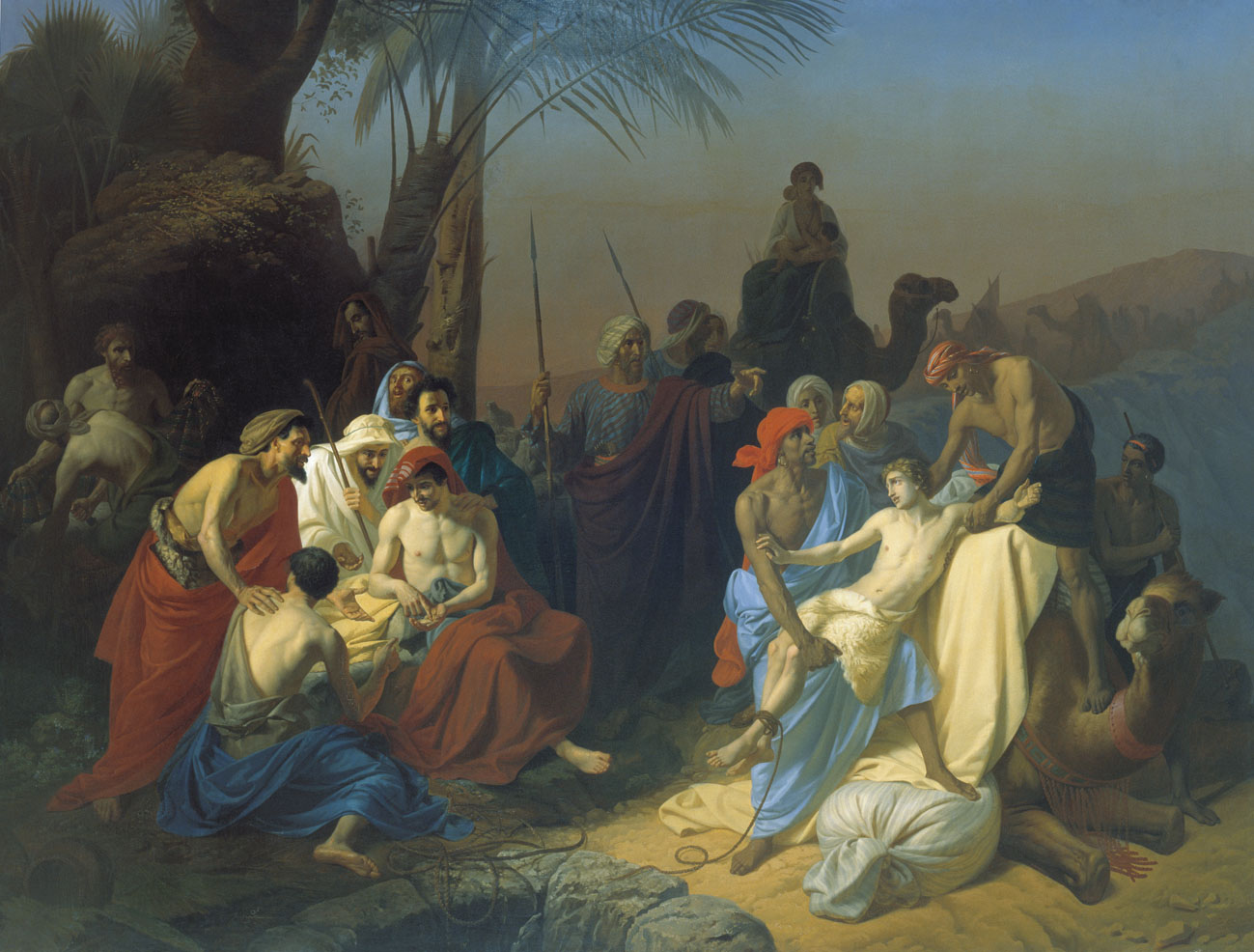
Very nice connection to Isaac. And when did Joseph’s male identity strengthen? Could it be that Potiphars wife’s attempts to seduce Joseph enhanced his sexual desires for women which may have been latent at that time? One year of tempting him everyday. The Midrash says that on the final day of temptation Joseph came to the house with the intention of sinning with her. That is the day he got sent to jail. It would seem therefore that one main purpose of being in Potiphar’s house was to bring out this male sexual desire. As such he no longer needed to be there. Just a thought.
It could be. However, it seems more likely to me that it is the ordeal of casting Joseph into a pit, which was in lieu of the Akeida, brought out his masculine personality. Also stripping him off his coat, which had been the symbol of his femininity, was an important step. Recall that only after adding a kolel Joseph’s gematria becomes equal to that of nukvah. IMHO, it was the coat that represented the kolel. Interestingly, Potiphar’s wife also stripped Joseph of a piece of his garment. There could be a connection there.
In addition, it seems that the fear or expectation of death of both Isaac at the Akeidah and Joseph in the pit (he was going to be left there to die) was enough to cause a soul exchange in Isaac and some sort of soul change (not sure what) in Joseph that results in the male trait/soul being enhanced.
In addition, both there deaths were to be by the hand of relatives and both were seen as justified (commanded by G-d in the case of isaac) and seen as justified by Joseph’s brothers.
Lastly, interesting to note that clothes items were used as false evidence in both isaac and Joseph’s episodes. After the Akeidah, isaac is deceived by Jacob that wore Essauv’s clothes. While after the bor incident, Joseph’s bloodied garment is used as false evidence against Jacob that Joseph was killed by wild animals. Maybe Jacob was deceived in the same manner he deceived his father as a punishment. Even though he was arguably justified in deceiving his father, he did cause him anguish and maybe should have apologized afterwards.
Yes, it is the anticipation of the imminent death that caused Isaac’s would to ascend and be switched with ints male counterpart. Something similar to that could have happened with Joseph–that was my thesis in this post. Alternatively, it could have been the psychological trauma that made a lasting change in Joseph’s personality forcing him to grow-up and assume his male persona.
As far as the connection between Jacob misleading his father Isaac with Esau’s cloth and being later misled by his children with Joseph coat, this mida-keneged mida (measure for measure) connection has been made by the classical Torah commentators.
Regarding the feminine tendency of Joseph. Lea conceived initially male and Rachel female. But then Lea prayed so that the genders will switch. Thus, Joseph initially was a female and after that a male. He was supposed to marry Dina but instead married her daughter Asnat
This is exactly right and it is the subject of the sequel I am writing now. Stay tuned.
So he was placed in the pit out of love and concern?
Your observations about J’s feminine leanings
Makes more sense if we argue the brothers were revolted by it.
Yes, this was tough brotherly love meant to bring out in Joseph his masculine persona.
“This new take on the Biblical conflict between Joseph and his brothers rooted in gender identity illuminates the contemporary discussions related to gender theory and gender identity.”
Illuminates in what way?
It’s for you to decide. :-)
Very interesting to read this history. I love to read history. Great job.
I share the story with my friends and family. Thank you for this article.